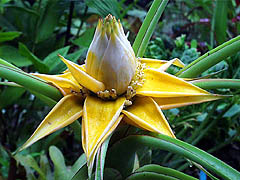An Exotic Beauty from China
By David A. Bar-Zvi
Curator of Herbaceous Monocots

The Musella lasiocarpa is now blooming in the conservatory nursery and can be seen through the window of the Garden Cafe.
Few recent visitors to the conservatory at Fairchild Tropical Botanic Garden could miss the flowering of the latest plant introduction in our collection of' zingiberales. Musella lasiocarpa has been in flower for the month of March and it looks as of this writing that it has a long way to go. It is one of two plants sent by Dr. W John Kress of the Smithsonian Institution last year. They were collected about 15 km from Kunming, China during a ginger symposium held in May 1995.
The countryside around Kunming is, as are many parts of China, intensively cultivated. Often every square meter of land is put to some agricultural use. Musella, it seems, is a common sight in this region. Farmers even use the plants as pig fodder. Oddly, almost no one outside of that region has seen it. Until now.
Kunming is located at the same latitude as the middle Florida Keys and about 5000 feet above sea level. The climate is spring-like, similar that of northern California and Oregon.
My first encounter with this strange banana-like plant occurred at a slide show at the 1992 Heliconia Society International biennial meeting in Cairns, Australia. A guest speaker from China presented some slides of possible ornamentals for the future. Musella lasiocarpa was included. The slides showed a large, bright yellow, spreading bud atop what appeared to be a four-foot banana plant. The plant was a gray-green color, with sturdy leaves. The ornamental appeal was clear-something new, weird and wonderful to add to our planting palate. At that time, planting material was not available, so we had to wait.
A year or so later, seeds of this Musella sp. arrived at a few places in South Florida, including Fairchild Tropical Botanic Garden and Flamingo Gardens. The hard, black, buckshot-sized seeds proved to be difficult and slow to germinate. There was no sign of germination after an entire year. After about 18 months, a few plants germinated at Flamingo Gardens, but did not flourish. The growth was slow; the leaves seem to be twisted. For a "banana", it was a slow plant. After about two months, raccoons made a meal of all of the seedlings and that was the end of the story. The remaining seeds never germinated.
Our plants from the Smithsonian were a different story. They arrived small, fitting comfortably in a gallon pot. One plant in particular grew very well, needing to be repotted within a month. Very soon, side shoots were visible at the base of the quickly expanding pseudostem. As the year progressed and the weather warmed, night plant growth slowed somewhat. Then it increased dramatically as the nights cooled off at the end of autumn. As winter approached it was apparent that a change was in the offing. The new leaves emerged with smaller blades. The apex began to swell. The whole crown of leaves bent downward exposing a brilliant yellow artichoke-like "bud". We watched with fascination, day by day. The first set of bracts opened to expose a few tubular yellow flowers. According to Dr. Kress, these would certainly be female flowers, occurring through abortion of the anthers, leaving the pistil in good condition. The subsequent development of the ovary of each flower indicates that the first flowers are indeed functionally female. As more bracts folded back, we found they were "blind" i.e. without flowers. In mid March, no more flowers had been disclosed. According to Dr. Kress, at later stages we can expect male flowers with withered pistils but fertile anthers. Some of the middle bracts may contain flowers which are completely hermaphroditic. We just have to wait and learn. As far as anyone knows this is the very first plant of this species to flower in North America and it is unlikely that Musella will be a common sight soon. There is a lot to learn. As the curator of collections which include this family, I hope to try this dramatic plant outside.
As a landscape item, Musella lasiocarpa could be well used in a group planting where some individuals are in flower while others are in foliage. The effect of the "flowers" is rather dramatic, like a King Protea, or a large, ornamental yellow thistle. For now, the plants are available only at a very high cost from specialty nurserymen and Western horticulturists just are beginning to learn how to grow them. Given the determination of plant specialist addicts, we shall no doubt be seeing more of this species.